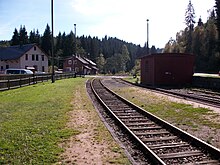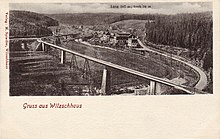Schönheide Süd station
| Schönheide south | |
|---|---|
|
Station building, standard gauge side (2015)
|
|
| Data | |
| Operating point type | former train station |
| Location in the network | former connection station |
| Platform tracks | 2 |
| abbreviation | DSNS |
| opening | September 7, 1875 |
| Conveyance | February 28, 1998 |
| location | |
| City / municipality | Schönheide |
| country | Saxony |
| Country | Germany |
| Coordinates | 50 ° 28 '26 " N , 12 ° 30' 55" E |
| Height ( SO ) | 569 m |
| Railway lines | |
|
|
| Railway stations and stops in Saxony | |
The station Schönheide Süd (to 1950 Station Wilzschhaus ) is a railway station in southwest Saxony .
history
The station with the Chemnitz – Aue – Adorf line was opened on September 7, 1875 . In 1892/93, in connection with the construction of the Wilkau-Haßlau-Carlsfeld narrow-gauge railway, the station was completely rebuilt. In contrast to the Wilkau-Haßlau station , Wilzschhaus was designed from the outset to be free of intersections between normal and narrow-gauge railway . Among others were a new reception building , a goods shed , a Umladehalle , an outbuilding and two officers houses built. With the opening of the narrow-gauge railway from Saupersdorf on December 16, 1893, Wilzschhaus became a connecting station. In 1897 the narrow-gauge railway was extended to the neighboring Carlsfeld , with another bridge over the Zwickauer Mulde and another narrow-gauge track built. Since there was no longer any space for a loading road in the narrow, narrow-gauge section between the river and the standard-gauge railway , this was built on the other side of the Mulde bridge on the route to Carlsfeld. A loading street track and a wooden ramp were built there in 1898. On June 1, 1900, Wilzschhaus was elevated to a train station.
In 1907 the two Wernesgrüner brewery owners had a trolley pit built for the transition from standard-gauge wagons to the narrow-gauge railway to reduce transport costs for the breweries . This meant that standard-gauge freight wagons could be pushed onto low, special narrow-gauge wagons and brought to their destination on the narrow-gauge without the freight having to be reloaded. The standard-gauge wagons towered over the narrow-gauge locomotives considerably. The weight to be pulled often made the leader of two locomotives necessary. The transport was only possible on routes whose bridge loading and culverts as well as their superstructure allowed this. This was initially permitted from the Schönheide Süd station to Rothenkirchen.
At the end of the Second World War on April 25, 1945, SS units blew up a pillar of the Mulden Viaduct from Wilzschhaus on the narrow-gauge railway. In July 1945, the train service could be resumed.
In 1950, the station name Wilzschhaus was changed to the name Schönheide Süd , which is still in use today , despite the considerable distance to the town of Schönheide, which is now eponymous . Schönheide now had a total of five train stations and stops.
During operation, a number of industrial accidents also occurred at Schönheide Süd station, particularly during shunting operations. In 1953, the brakes failed on a train coming from Schönheide West that was loaded with 153 tons on 36 axles, so that it became faster and faster on the downhill section to Schönheide Süd station, passed through this station and only came to a stop again when the route rose again in the direction of Carlsfeld.
Between 1966 and 1977, passenger and freight traffic on the narrow-gauge railway was gradually discontinued, so that Schönheide Süd became a simple through station again. The transshipment hall had already been demolished in 1975 to make room for wood handling for the brush industry at Stützengrün. After the tourist traffic to Schönheide Ost had already been discontinued in January 1979, passenger traffic to Schönheide Süd ended in May 1982. Schönheide Süd was still served in freight traffic until 1994, when the route was closed. From then on, the station remained unused. The tracks and systems were not dismantled on the standard gauge line. In contrast, the former narrow-gauge area was converted into a storage area in 1988. The iron basin bridge of the large viaduct was dismantled in 1980, the pillars remained.
Museum railroad projects

At the beginning of the 21st century, part of the narrow-gauge tracks was rebuilt by the historical Westsächsische Eisenbahnen eV association . The standard-gauge railway from Schönheide Süd to Muldenberg was reactivated for museum operation. In the direction of Muldenberg, trains have been running on the days of travel for several years, including with the Wernesgrüner rail express. Further plans include the expansion of the museum train service to Schönheide Ost (see Schönheiderhammer ). Plans to enable the connection of standard and narrow-gauge railways in Wilzschhaus after the rebuilding of the Wilzschhausen Viaduct were abandoned in 2013 after most of the municipalities and districts affected refused to participate. But in perspective, museum traffic to Carlsfeld is envisaged. Realizing it is very complex just because of the dismantled bridge over the Zwickauer Mulde. In order to ensure long-term operation of the museum railway, the Association for the Promotion of Historic West Saxon Railways bought the entire railway line between Schönheide Ost and Muldenberg in 2017.
literature
- Rainer Heinrich, Gordon Parzyk: The narrow-gauge railway Wilkau-Haßlau-Carlsfeld , Regionale Verkehrsgeschichte: Volume 2 , EK-Verlag, Freiburg 1995, ISBN 3-88255-418-5 , 240 pages (The volume contains a description of the Schönheide Süd junction, the History of its creation, its expansion, its traffic and its loss of importance due to the successive line closures, timetables, station plans, black-and-white and color photos.)
- Karl Wolf and Ludger Kenning: Wilkau-Haßlau-Carlsfeld. The first and longest Saxon narrow-gauge railway. (= Secondary railway documentation. Vol. 14), Kenning, Nordhorn 1995, ISBN 3-927587-42-7 , 98 pages (This work also describes the importance of Schönheide Süd as a junction and shows it in black-and-white and color photos. A track plan from Schönheide Süd shows the intersection-free separation of narrow and standard gauge.)
Web links
- Data and pictures on sachsenschiene.net
- 99 1568 near Schönheide Süd 1976 on the Joachim Schmidt Railway Foundation
Individual evidence
- ^ Wilfried Rettig: The railways in Vogtland - Volume 1: Development, main lines, vehicles, depot and buildings , EK-Verlag, Freiburg 2001, p. 88
- ↑ Rainer Heinrich, Gordon Parzyk: The history of narrow gauge railway Wilkau-Haßlau-Carlsfeld , publisher German Reichsbahn, Bahnmeisterei Falkenstein / Vogtland Falkenstein / Vogtland 1988, page 52
- ↑ Rainer Heinrich, Gordon Parzyk: The history of narrow gauge railway Wilkau-Haßlau-Carlsfeld , publisher German Reichsbahn, Bahnmeisterei Falkenstein / Vogtland Falkenstein / Vogtland 1988, page 55
- ↑ Rainer Heinrich, Gordon Parzyk: The history of the narrow-gauge railway Wilkau-Haßlau-Carlsfeld , publisher Deutsche Reichsbahn, Bahnmeisterei Falkenstein / Vogtland, Falkenstein / Vogtland 1988, pages 57 to 59
- ↑ Rainer Heinrich, Gordon Parzyk: The history of narrow gauge railway Wilkau-Haßlau-Carlsfeld , publisher German Reichsbahn, Bahnmeisterei Falkenstein / Vogtland Falkenstein / Vogtland 1988, pages 111, 116
- ↑ Report in the Freie Presse on January 14, 2014 ( online version )
- ↑ FHWE website , accessed on December 11, 2018
- ↑ News from August 15, 2017 on the FHWE.de website, accessed on December 11, 2018




